Red Harvest
Nearly every summer dating back 120 years, the orchards along Flathead Lake have shined bright with groves of cherries, renewing an iconic tradition
By Dillon Tabish
FINLEY POINT — By the early morning of July 13, only a few days after word spread across the West, vehicles filled a large parking lot near the east-side shore of Flathead Lake. The licenses plates stretched as far away as California, but many were from Washington, where the robust summer fruit harvest had ended days earlier.
In an annual pilgrimage that can draw more than 1,000 people from all over the region, groups of migrant workers — either individual men and women or families of all ages, sometimes stretching three generations — arrived at the shores of Flathead Lake for the sudden scramble of cherry season.
Fidel Gomez, a single father with a 9-year-old daughter and 7-year-old son, followed the advice of his parents, who have been traveling here for several years and have extolled the annual summertime journey as advantageous. His children came last year with Gomez’s sister, and after hearing about this season’s crop, Fidel decided to make the trek from his home in Washington.
“It’s exciting. The kids are excited and they love coming here,” Gomez, 34, said last week. “It’s kind of a family reunion. My family come from all over. There’s a lot of work.”
Among pickers, growers and consumers alike, Flathead’s iconic cherries have a reputation stretching far and wide.
Dating back to the first orchard planted in 1893 in the favorable microclimate along the east side of Flathead Lake, the sweet cherry harvest has been a beloved tradition. Flathead’s cherries — large, juicy and ruby-red — have a unique identity made from an ideal recipe — glacial waters, clean soil and the temperate, sunny climate along the largest natural freshwater lake in the West.
Over 120 growers boast orchards along Flathead Lake, and the area has produced as much as 7 million pounds of cherries in a season.
A good year will hit 3 million, but it all depends on Mother Nature. The season typically starts in late July and ends in early August. But so many factors come into play that can help or hurt growers and pickers.
An extreme example occurred in the late 1980s when a severe frost swept the region in winter, killing groves and forcing growers to replant their orchards. It took several years before Flathead cherries made a comeback and produced even somewhat of a normal crop.
Last year’s dry, hot summer led to a brutal crop that offered only a few days of work for pickers and created a financially painful harvest for growers.
This summer’s season started a few weeks early — around July 9 — because of spring’s abundant sunshine and favorable weather, but the rainstorms that swept the valley in the last week didn’t help the cherries, which can split easily with precipitation.
Yet the first week of the season went off with a fairly good harvest, according to many growers.
Many of these Flathead cherries stay local and are sold at stands along the highway or in towns across the state, although quite a few growers ship their harvests north to Canada or west to Washington, where they are loaded onto planes or trains destined for supermarkets across the U.S., Europe, Asia and beyond. For the last 16 years, the Flathead Lake Cherry Growers Association, encompassing roughly 70 producers, has shipped about 80 percent of the seasonal crop to Selah, Washington, where the cherries are packed and sold through Domex Superfresh Growers, which supplies fruits to stores across the West.
The cherries are so prized that a new juicing facility is being established at Finley Point that could use upwards of 600,000 pounds of cherries that are typically picked but thrown away for minor defects, such as splitting.

During this brief window of a season, skilled pickers are in high demand. Many orchards have established working relationships with migrant families from across the Pacific Northwest. These workers travel the West Coast for the various fruit and vegetable seasons before coming to Montana for the region’s final cherry season of the year.
The influx of temporary workers is so significant that 35 years ago Montana Rural Employment Opportunities, a statewide nonprofit that helps underemployed and unemployed farm workers, established a site at Finley Point with food, medical and education services during the roughly two-week season. The program began by offering food and gas vouchers to the migrant workers in need, and it has grown to now include a full offering of training programs, food and health services.
Staffed largely by volunteers, the REO program annually orders roughly 30,000 pounds of food to be given to the workers in organized packages when they arrive.
Will Bodle, the manager of REO’s Flathead Lake services, said the goal is to help the families settle into a new place before they start receiving payment for their work. In a typical summer, the program will serve roughly 200 individuals and 350 families, with most families consisting of four people.
“Until you’ve actually sat across the table from these people, these are some of the people who have the least,” Bodle said. “They are extremely hard working. For the most part, they are fairly poor but they are some of the most giving people I’ve ever met in my life.”
A migrant worker is defined by the federal government as someone who leaves home for 24 hours for his or her job. Any migrant worker who receives food or other services through REO must fill out an application, which requires them to be a legal U.S. citizen or have a proper working visa or green card.
Most of the migrant workers who arrive to pick cherries are Hispanic. They often come from families that travel a network of states where fruit harvests can stretch throughout the year.
Gomez, who arrived here with his two young children last week, began working as a commercial picker when he was a teenager, following the work of his father and mother and other extended family.
“Most of my family start down in California and they work their way up here,” he said. “We travel a lot. But I think it’s pretty cool.”
Migrant workers are paid in a variety of ways. Some are paid by the hour, ranging roughly $9.60 to $11 an hour, according to REO staff. Some orchards pay their workers by the bin — roughly $40 a bin — and a good picker can fill 10 to 15 bins a day. The average worker picks from daylight until 1 p.m. or when the temperature hits 80 degrees.
“If the cherries are good, they can make good money,” said Jesse Bonilla, who has worked with REO along Flathead Lake since 1992. “If the cherries aren’t good, they don’t make good money.”
Bonilla said he has seen generations of families come to pick cherries in the Flathead.
“One of the first families I met when they were young in the early 90s, the kids are now all grown up and still coming. It’s rewarding to see them all and to see all the kids grow up. They come and enjoy what they do,” Bonilla said.

Many of the workers sleep in tents in the cherry groves where they work. Some stay in trailers or campers.
While the adults are working, children are enrolled in the Flathead Lake Migrant Education Program, the largest migrant education summer program in the state. The site-based program at Polson Middle School provides an educational experience that helps children make up for lost classes and other learning shortfalls that result from repeated moves. It also provides a safe place for children while their parents are working.
John Johnson has worked with the Migrant Education Program since 1994 and has enjoyed seeing the annual arrival of families from across the region.
“It’s hard work,” Johnson said. “Sometimes there is an idea to look down at people in farm work, but we wouldn’t be eating if we didn’t have good farm workers. We should all appreciate them. We need to appreciate people who work hard.”
For more information about Montana REO or to volunteer, visit http://reomontana.org or call Bodle at 406-274-4172 or email [email protected].

The History of Flathead Lake’s Iconic Cherries
If Northwest Montana seems like an unlikely source of sweet cherries, that’s because it is. The bright-red, non-citrus fruit isn’t native to Montana, yet the Flathead’s orchards produce some of the region’s finest cherries on an annual basis.
The abundance of cherries around Flathead Lake dates back 123 years. As the legend goes, Margaret Estey planted the first sweet cherry orchard on the lake’s east shore in 1893. She planted the trees with the help of her sister-in-law, who was married to John C. Wood, for whom Woods Bay was named. Estey was born in Nova Scotia, Canada, in 1865 and had moved around the U.S. in her younger years as her parents chased the mining boom, which led them to Butte in covered wagons that were drawn by mule teams owned by Wood.
After arriving on the east shore of Flathead Lake, Estey noticed that the microclimate around the massive lake could be conducive for large, sweet cherries and other unique crops, such as walnut and hazelnut trees. Long, warm days with plenty of sunshine and night temperatures of 40 to 50 degrees were common around Flathead Lake, as well as glacier-fed water and well-drained soil.
Estey planted the first orchard as an experiment. Cherry trees begin bearing fruit after five years, and, lo and behold, Estey noticed the arrival of red fruit springing up along the lakeshore.
By the 1920s, the juicy fruit was so popular that it expanded into a commercial crop after the Robbin brothers of Kalispell planted 700 trees near Yellow Bay. Montana’s first traincar load of Lambert variety cherries left the original packing plant in Kalispell in 1932. In 1935, a cherry grower’s cooperative, now called the Flathead Lake Cherry Growers, Inc., was organized.
Cherry orchards began popping up all along the lakeshore as Flathead Lake cherries became a known commodity sold across the U.S. A mature sweet cherry tree is capable of producing more than 100 pounds of fruit in a season. Trees bear ripe fruit from late July through mid-August. The Flathead area has produced as much as 7 million pounds in a season, but the normal average is approximately 3 to 5 million pounds.
Today there are over 120 growers in the Flathead region dedicated to producing the savory cherries, which have become the lake’s iconic fruit.
And it all dates back to the one orchard planted by Estey, who passed away at the age of 85 in the spring of 1950. She was buried at the C.E. Conrad Memorial Cemetery in Kalispell, and her legacy remains as the matriarch of Flathead Lake cherries.